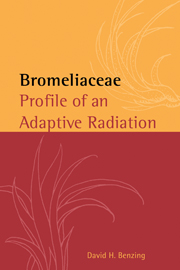Book contents
- Frontmatter
- Contents
- List of contributors
- Preface
- Acknowledgments
- Glossary
- Abbreviations
- Part one Brief overview
- Part two Basic structure, function, ecology and evolution
- 2 Vegetative structure
- 3 Reproductive structure
- 4 Carbon and water balance
- 5 Mineral nutrition
- 6 Reproduction and life history
- 7 Ecology
- 8 Relationships with fauna
- 9 History and evolution
- Part three Special topics
- Literature cited
- Name index
- Subject index
- Taxon index
7 - Ecology
from Part two - Basic structure, function, ecology and evolution
Published online by Cambridge University Press: 19 January 2010
- Frontmatter
- Contents
- List of contributors
- Preface
- Acknowledgments
- Glossary
- Abbreviations
- Part one Brief overview
- Part two Basic structure, function, ecology and evolution
- 2 Vegetative structure
- 3 Reproductive structure
- 4 Carbon and water balance
- 5 Mineral nutrition
- 6 Reproduction and life history
- 7 Ecology
- 8 Relationships with fauna
- 9 History and evolution
- Part three Special topics
- Literature cited
- Name index
- Subject index
- Taxon index
Summary
Considerations of the relationships between Bromeliaceae and climate and substratum emerge repeatedly in the chapters devoted to plant structure, physiology and reproduction. Nevertheless, many aspects of ecology either go unmentioned or warrant greater attention in a monograph that claims adaptive radiation as its central theme. This chapter and the following one address this deficiency by revisiting the diverse and often demanding growing conditions experienced by the bromeliads through tropical America. It also raises the less familiar issue of how hosting ecosystems owe many of their important attributes to the presence of these often keystone species. Chapter 8 highlights many of the most intimate associates of the bromeliads, namely their pathogens and predators, and especially the mutualists.
Several facts in addition to our focus on evolution oblige the emphasis on ecology. First, dense populations of epiphytic Bromeliaceae and companion flora demonstrably influence the structure, economy and carrying capacity of many Neotropical forests. The terrestrials in turn sometimes constitute much of the understory, and where trees are scattered or absent they may dominate entire ecosystems. A number of saxicoles achieve near monoculture on precipitous outcrops (Figs. 1.2C, 7.1). Finally, tankforming and bulb-producing Bromeliaceae engage in beneficial exchanges with a variety of nonpollinating and/or seed-dispersing invertebrates and higher animals. Services rendered to the extensive fauna that use these plants surely exceed in kind, if not also in abundance, those provided by members of just about any of the other families of herbs present in the same communities.
- Type
- Chapter
- Information
- BromeliaceaeProfile of an Adaptive Radiation, pp. 329 - 404Publisher: Cambridge University PressPrint publication year: 2000



